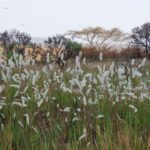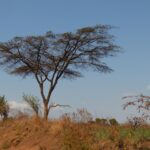We leave the Nyika plateau to the north. The endlessly long Chisenga pass is interspersed with boulders, has deeply washed out gullies and behind an unpaved edge it drops steeply into the depth. 150 km to the next tarred road. 150 km that take 7 hours.
As remote as the road is, there are always small villages. Often they seem to consist only of children. Three huts, but 20 children between 5 and 10 years. And everyone is happy, waves and shouts when we pass by. Also the adults: First they only observe and as soon as you smile at them or wave at them, they shine, laugh and wave. Really friendly people, these Malawians. And since we are, too, we constantly wave to the left and right – like Prince and Princess at the carnival procession.
The trip ended in Karonga at Lake Malawi. Here Friedemann Schrenk, the former curator at the Darmstadt museum, today professor at the University of Frankfurt and at the Senckenberg Research Institute, discovered a fossil of „homo rudolfensis“ and thus proved that this area was populated more than two million years ago by early representatives of the genus Homo.
We spend the night in our campers in front of a somewhat run-down motel on the beach. At least we can connect the extension cable for the operation of our refrigerator, which only runs with 220 volts, but no longer with the 24 volts in the car. But electricity does not arrive until about 8 pm – in Malawi there is usually only 16 hours of electricity a day, in the final phase of the dry season, when the water reservoirs are empty, often only for 8 hours. When we arrive, the empty motel is fully booked. Later we will see how an empty motel can be fully booked: It is a hotel that charges by the hour. And we are right in the middle of it. Just for today. We will leave for Tanzania soon.
Wir verlassen das Nyika-Plateau Richtung Norden. Der endlos lange Chisenga-Pass ist von Felsbrocken durchsetzt, hat tief ausgewaschene Rinnen und hinter einer unbefestigten Kante fällt er steil in die Tiefe ab. 150 km bis zur nächsten Teerstraße. 150 km für die wir 7 Stunden brauchen.
So abgelegen die Strecke auch ist, gibt es ständig kleine Dörfer. Oft scheinen sie nur aus Kindern zu bestehen. Drei Hütten, aber 20 Kinder zwischen 5 und 10 Jahren. Und alle freuen sich und winken und rufen, wenn wir vorbeifahren. Auch die Erwachsenen: Erst beobachten sie nur und sobald man sie anlächelt oder anwinkt, strahlen sie, lachen und winken. Wirklich ein freundliches Völkchen, diese Malawier. Und da wir das auch sind, winken wir ständig nach links und rechts – wie das Prinzenpaar beim Rosenmontags-Umzug. Und da uns ja eh keiner versteht, wird aus „Hello“ auch mal ein „Helau“ und ein „Alaaf“.
Aber auch diese Strecke hat ein Ende – in Karonga am Malawisee. Hier in der Nähe hat Friedemann Schrenk, der ehemalige Kustos am Landesmuseum in Darmstadt, heute Professor an der Uni Frankfurt und am Senckenberg Forschungsinstitut, ein Fossil des „homo rudolfensis“ entdeckt und damit belegt, dass das Gebiet des heutigen Malawi bereits vor mehr als zwei Millionen Jahren von unseren frühen Vorfahren besiedelt war.
Wir nächtigen im Auto vor einem etwas heruntergekommenen Motel am Strand. Wenigstens können wir das Verlängerungskabel für den Betrieb unseres Kühlschranks anschließen, der nur noch mit 220 Volt, aber nicht mehr mit den 24 Volt im Auto läuft. Strom kommt aber erst gegen 20 Uhr – in Malawi gibt es meist nur 16 Stunden Strom am Tag, in der Endphase der Trockenzeit, wenn die Wasserspeicher leer sind, oft nur für 8 Stunden. Als wir ankommen, ist das menschenleere Motel „fully booked“. Später sehen wir, wie ein leeres Motel „fully booked“ sein kann: Es ist ein Stundenhotel. Und wir stehen mittendrin. Aber nur heute. Jetzt geht’s weiter nach Tansania.



Schreibe einen Kommentar